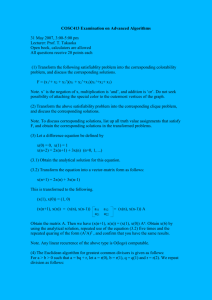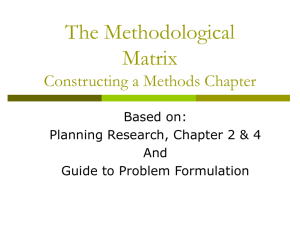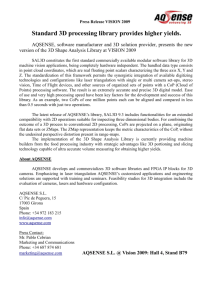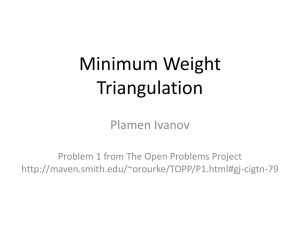THE EXISTENCE OF QUASIMEROMORPHIC MAPPINGS Emil Saucan
advertisement
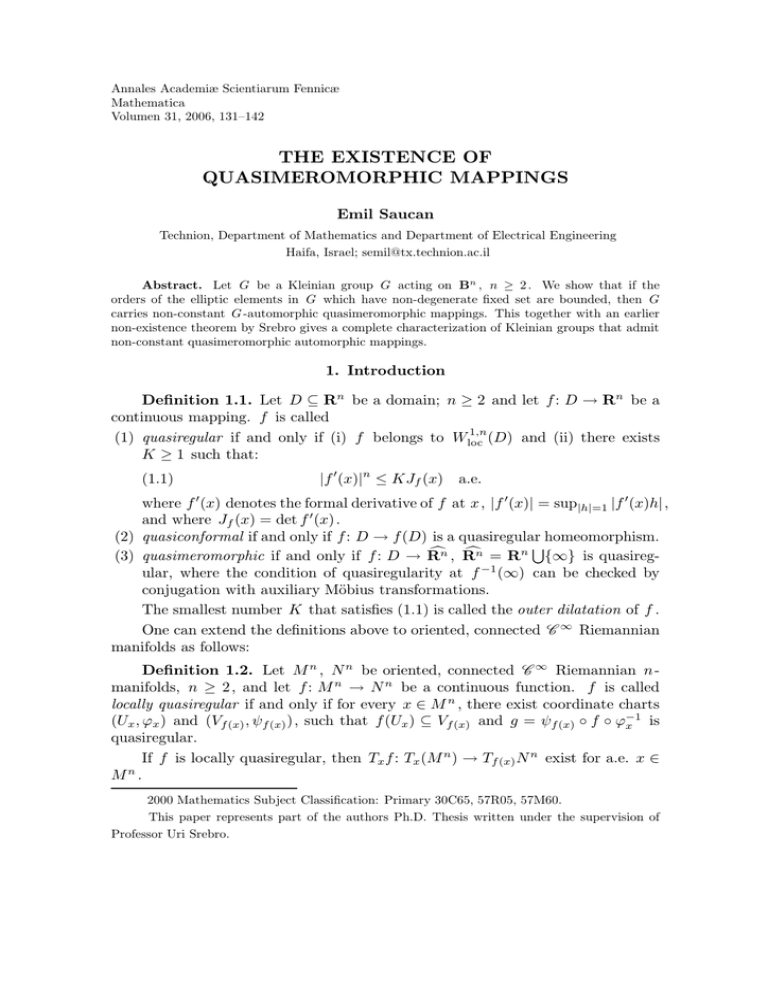
Annales Academiæ Scientiarum Fennicæ
Mathematica
Volumen 31, 2006, 131–142
THE EXISTENCE OF
QUASIMEROMORPHIC MAPPINGS
Emil Saucan
Technion, Department of Mathematics and Department of Electrical Engineering
Haifa, Israel; semil@tx.technion.ac.il
Abstract. Let G be a Kleinian group G acting on Bn , n ≥ 2 . We show that if the
orders of the elliptic elements in G which have non-degenerate fixed set are bounded, then G
carries non-constant G -automorphic quasimeromorphic mappings. This together with an earlier
non-existence theorem by Srebro gives a complete characterization of Kleinian groups that admit
non-constant quasimeromorphic automorphic mappings.
1. Introduction
Definition 1.1. Let D ⊆ Rn be a domain; n ≥ 2 and let f : D → Rn be a
continuous mapping. f is called
1,n
(D) and (ii) there exists
(1) quasiregular if and only if (i) f belongs to Wloc
K ≥ 1 such that:
(1.1)
|f 0 (x)|n ≤ KJf (x) a.e.
where f 0 (x) denotes the formal derivative of f at x , |f 0 (x)| = sup|h|=1 |f 0 (x)h| ,
and where Jf (x) = det f 0 (x) .
(2) quasiconformal if and only if f : D → f (D) is a quasiregular homeomorphism.
cn , R
cn = Rn S{∞} is quasireg(3) quasimeromorphic if and only if f : D → R
ular, where the condition of quasiregularity at f −1 (∞) can be checked by
conjugation with auxiliary Möbius transformations.
The smallest number K that satisfies (1.1) is called the outer dilatation of f .
One can extend the definitions above to oriented, connected C ∞ Riemannian
manifolds as follows:
Definition 1.2. Let M n , N n be oriented, connected C ∞ Riemannian n manifolds, n ≥ 2 , and let f : M n → N n be a continuous function. f is called
locally quasiregular if and only if for every x ∈ M n , there exist coordinate charts
(Ux , ϕx ) and (Vf (x) , ψf (x) ) , such that f (Ux ) ⊆ Vf (x) and g = ψf (x) ◦ f ◦ ϕ−1
is
x
quasiregular.
If f is locally quasiregular, then Tx f : Tx (M n ) → Tf (x) N n exist for a.e. x ∈
Mn .
2000 Mathematics Subject Classification: Primary 30C65, 57R05, 57M60.
This paper represents part of the authors Ph.D. Thesis written under the supervision of
Professor Uri Srebro.
132
Emil Saucan
Definition 1.3. Let M n , N n be oriented, connected C ∞ Riemannian n manifolds, n ≥ 2 , and let f : M n → N n be a continuous function. f is called
quasiregular if and only if
(i) f is locally quasiregular
and
(ii) there exists K , 1 ≤ K < ∞ , such that
(1.2)
|Tx f |n ≤ KJf (x)
for a.e. x ∈ M n .
Recall that a group G of homeomorphisms acts properly discontinuously on
a locally compact topological space X if and only if the following conditions hold
for any g ∈ Gx , x ∈ X : (a) the stabilizer Gx = {g ∈ G | g(x) = x} of x is finite;
and (b) there exists a neighbourhood Vx of x , such that (b1 ) g(Vx ) ∩ Vx = ∅ , for
any g ∈ G \ Gx ; and (b2 ) g(Vx ) ∩ Vx = Vx .
Definition 1.4. A discontinuous group of orientation-preserving isometries
of Bn is called a Kleinian group.
It is well known that a discontinuous group is discrete (see [Ms]).
cn , and let G be a Kleinian group acting
Definition 1.5. Let f : Bn → R
upon Bn . The function f is called G -automorphic if and only if:
(1.3)
f g(x) = f (x); for any x ∈ Bn and for all g ∈ G;
Recall the definition of elliptic transformations:
Definition 1.6. A Möbius transformation f : Bn → Bn , f 6= Id is called
elliptic if and only if f has a fixed point in Bn .
The existence of non-constant automorphic meromorphic functions in dimension n = 2 represents a classical result which follows from the existence of meromorphic functions on Riemann surfaces (see [Fo], [K]).
The question whether quasimeromorphic mappings (or qm-mappings, in short)
exist in any dimension n ≥ 3 was originally posed by Martio and Srebro in [MS1];
subsequently in [MS2] they proved the existence of the fore-mentioned mappings
in the case of co-finite groups, i.e., groups such that Volhyp (Bn /G) < ∞ (the important case of geometrically finite groups being thus included). Also, it was later
proved by Tukia ([Tu]) that the existence of non-constant qm-mappings is assured
in the case when G acts torsionless upon Bn . Moreover, since for torsionless
Kleinian groups G , Bn /G is an (analytic) manifold, the next natural question to
cn ; where M n is
ask is whether there exist non-constant qm-mappings f : M n → R
an orientable n -manifold. A partial affirmative answer to this question is due to
Peltonen (see [Pe]); to be more precise she proved the existence of qm-mappings
in the case when M n is a complete, connected, orientable C ∞ -Riemannian manifold.
Our main result is the following theorem:
The existence of quasimeromorphic mappings
133
Theorem 1.7. Let G be a Kleinian group G acting on Bn , n ≥ 2 . If the orders of the elliptic elements of G which have non-degenerate fixed set are bounded,
then G admits non-constant G -automorphic quasimeromorphic mappings.
In contrast with the above results it was proved by Srebro ([Sr]) that, if
G is a Kleinian group acting on Bn , n ≥ 3 , containing elliptic elements with
non-degenerate fixed set, of arbitrarily large orders, then G does not admit nonconstant G -automorphic qm-mappings; and showed that such groups exist in all
dimensions n ≥ 3 .
This non existence result, together with Theorem 1.7 gives a complete characterization of those Kleinian groups which admit G -automorphic quasimeromorphic
mappings. Namely:
Theorem 1.8. Let G be a Kleinian group acting on Bn . Then G admits
non-constant automorphic qm-mappings if and only if :
(1) n = 2 ;
or
(2) n ≥ 3 , and the orders of the elliptic elements of G having non-degenerate
fixed sets are uniformly bounded.
Remark 1.9. Given any finitely generated Kleinian group acting on B3 the
number of conjugacy classes of elliptic elements is finite (see [FM]). However, this
is not true for Kleinian groups acting upon Bn , n ≥ 4 ; (for counterexamples, see
[FM], [Po] and [H]).
Remark 1.10. Hamilton ([H, Theorem 4.1]) constructed examples of
Kleinian groups G acting on B4 such that there exists an infinite sequence
{fn }n∈N ⊂ G of elliptic transformations, with ord (fn ) → ∞ and such that
the fixed set of each fn is degenerate. (For the relevant definitions, see Section 2
below.) (Here ord (fn ) denotes the order of fn .)
Note that by Remark 1.9 we have the following corollary:
Corollary 1.11. Let G be a finitely generated Kleinian group acting upon
c3 .
B . Then there exists a non constant G -automorphic qm-mapping f : B3 → R
3
The classical methods employed in proving the existence in the case n =
2 do not apply in higher dimensions—indeed, for n ≥ 4 , Bn /G is not even a
manifold, but an orbifold. Therefore, different methods are needed. Following
other researchers, we shall employ the classical “Alexander trick” (see [Al]).
A uniform bound for the dilatations can be attained (see [MS2], [Tu]) if the
considered triangulation is fat, i.e. such that each of its individual simplices may
be mapped onto a standard n -simplex, by a L -bilipschitz map, followed by a
homothety, for a fixed L . (For a precise definition of fatness see Section 3 below.)
The idea of the proof of Theorem 1.7 is, in a nutshell, as follows: Based
upon the geometry of the elliptic transformations construct a fat triangulation
134
Emil Saucan
T1 of Ne∗ , where Ne∗ is a certain closed neighbourhood
of the singular set of
Bn /G . Since Mp = Bn \ Fix(G) /G , Fix(G) = x ∈ Bn | there exists g ∈
G \ {Id}, g(x) = x is an orientable analytic manifold, we can apply Peltonen’s
result to gain a triangulation T2 of Mp . Therefore, if the triangulations T1 and
T2 are chosen properly, each of them will induce a triangulation of Ne∗ \ Ne∗ 0 , for
a certain Ne∗ 0 ( Ne∗ (see Section 2).
‘Mash’ T1 and T2 (in Ne∗ \ Ne∗ 0 ) i.e. ensure that the given triangulations
intersect into a new triangulation T0 (see [Mun, Theorem 10.4]). Modify T0 to
receive a new fat triangulation T of Bn /G .
In the presence of degenerate components Ak = A(fk ) of the fixed set of G ,
where the transformations fk may have arbitrarily large orders, a modification of
this construction is needed; see Section 4.
Apply Alexander’s trick to receive a quasimeromorphic mapping f : Bn /G →
cn . The lift f˜ of f to Bn represents the required G -automorphic quasimeroR
morphic mapping.
In [S3] we showed how to build T1 using a generalization of a theorem of
Munkres ([Mun, 10.6]) on extending the triangulation of the boundary of a manifold (with boundary) to the whole manifold. Munkres’ technique also provided us
with the basic method of mashing the triangulations T1 and T2 . In this paper we
present a more direct, geometric method of triangulating Ne∗ and mashing the two
triangulations. We already employed this simpler method in [S1], where we proved
Theorem 1.7 in the case n = 3 . The original technique used in [S1] for fattening
the intersection of T1 and T2 is, however, restricted to dimension 3 . Therefore
here we make appeal to the method employed in [S3], which is essentially the one
developed in [CMS].
This paper is organized as follows: in Section 2 we show how to triangulate
the closed neighbourhood Ne∗ of the singular set of Bn /G . Section 3 is dedicated
to the main task of mashing the triangulations and fattening the resulting common triangulation. In Section 4 we show how to apply the main result in the
cn .
construction of a G -automorphic quasimeromorphic mapping from Bn to R
2. Geometric neigbourhoods
If G is a discrete Möbius group and if f ∈ G , f 6= Id is an elliptic transformation, then there exists m ≥ 2 such that f m = Id . The smallest m satisfying
this condition is called the order of f , and it is denoted by ord(f ) . In the 3 dimensional case the fixed point set of f , i.e. Fix(f ) = {x ∈ B3 | f (x) = x} ,
is a hyperbolic line and will be denoted by A(f ) —the axis of f . In dimension
n ≥ 4 the fixed set (or axis of f ) of an elliptic transformation is a k -dimensional
hyperbolic plane, 0 ≤ k ≤ n − 2 . An axis A is called degenerate if and only if
dim A = 0 . In dimensions higher than n = 3 , different elliptics may have fixed
sets of different dimensions.
The existence of quasimeromorphic mappings
135
If G is a discrete group, G is countable and so is the set of elliptics and the
set of connected components of Fix(G) , which we denote by {fi }i≥1 and {Cj } ,
respectively.
Moreover, by the discreteness of G , the sets A = {Ai≥0 } —and hence S =
{Cj } —have no accumulation points in Bn .
N(A)
= N(f)
r
r
{4}
O
+
int{4} A(f)
f = (4)
A(f)
H3 ≡ B3
Figure 1. Geometric neighbourhood for n = 3 and m = 4 . Here {4} denotes the regular
(hyperbolic) polygon with 4 sides.
Hence we can choose disjoint, G -invariant neighbourhoods Nj and Nj0 of
Cj , Nj0 ( Nj . Indeed, first choose a neighbourhood N1 of C1 , such that N 1 ∩
S
j≥2 Cj = ∅ ; then recursively build a neighbourhood Nk of Ck , such that Nk ⊂
S
S
n
B \(N1 ∪· · ·∪Nk−1 ) and N k ∩ j>k Cj = ∅ , for all k ≥ 2 . Denote Ne = j∈N Nj ,
S
0
Ne0 = j∈N Nj0 . Define Ne∗ = (N e ∩ Bn )/G , Ne∗ 0 = (N e ∩ Bn )/G .
To produce the desired closed neighbourhood Ne∗ of the singular set of Bn /G
and its triangulation T1 , we first consider the case where Ci = A(f ) , for some
f ∈ G , and then construct a standard neighbourhood Nf = N A(f ) of the axis
of each elliptic element of G such that Nf ' A(f ) × I n−k , where A(f ) = Sk and
where I n−k denotes the unit (n−k) -dimensional interval. The construction of Nf
proceeds as follows: By [Cox, Theorem 11.23] the fundamental region for the local
action of the stabilizer group of the axis of f , Gf = GA(f ) = {g ∈ G | g(x) = x}
is a simplex or a product a simplices. Let Sf be the fundamental region (see
Figure 2).
Then we can define the generalized prism (or simplotope—see [Som, VII.25])
⊥
Sf , defined by translating Sf in a direction perpendicular to Sf , where the
translation length is disthyp Sf , A(f ) . It naturally decomposes into simplices
(see [Som, VII.25], [Mun, Lemma 9.4]). We have thus constructed an f -invariant
triangulation of a prismatic neigbourhood Nf of A(f ) . We can reduce the mesh
of this triangulation as much as required, while controlling its fatness by dividing
Sf into similar simplices and partitioning Nf into a finite number of radial strata
of equal width % . In the special case when the minimal distance between axes
136
Emil Saucan
δ = min disthyp A(f ), A(g) | g elliptic, g 6= f is attained we can chose % =
δ/κ0 , for some integer κ0 , and further partition it into ‘slabs’ of equal hight h . (In
particular one can use this approach in the case when G acts on B3 and it contains
no order two elliptics, since in this particular case, according to a result of Gehring
and Martin [GM1], the minimum exists and is strictly positive.) Henceforth we
shall call the neighbourhood thus produced, together with its fat triangulation, a
geometric neighbourhood.
A(f)
σ3
⊥
Sf
σ1
σ2
f
Figure 2. Canonical decomposition into simplices of Sf⊥ , for n = 3 .
Since the stabilizer Stab(A1,...,k ) of the intersection of axes A1,...,k = Ai1 ∩
· · · ∩ Aik is a finite subgroup of O + (n) , and since in any dimension there exist
only a finite number of such groups of orders ≤ M0 , for any M0 ∈ N (see [Cox,
Chapter 11]), the angles between the axes of transformations of orders ≤ m0 admit
a bound α = α(m0 , n) . Therefore, the intersection N (A1,...,k ) = Nf1 ∩ · · · ∩ Nfk
of the geometric neighbourhoods of several axes is also endowed with a natural fat
triangulation, invariant under the group G = hGf1 , . . . , Gfk i . (In the particular
case n = 3 one can choose as a geometric neighbourhood of A a regular or a
semi-regular polyhedron together with its interior (see Figure 3 below).
If q ∈ Bn , dim q = 0 , is a degenerate element of the singular locus, we replace
the tubular neighbourhood considered above by Pq ∪intPq , where Pq is a regular
polytope invariant under the stabilizer Gq of q in G , together with its canonical
simplicial subdivision (see [Cox, 7.6]). Indeed, every finite group generated by
reflections is the symmetry group of a regular polyhedron P (see [Cox, p. 209]).
Moreover, the rotation group of P has order nl/2 , where l is the number of faces
of P (see [Cox, pp. 227–231]).
Remark 2.1. As noted above,
if G is a Kleinian group acting with torsion
on Bn , then Mp = Bn \ Fix(G) /G is a complete orientable manifold. Moreover,
since the isotropy groups of any point in QG = Bn /G are subgroups of O + (n) , it
The existence of quasimeromorphic mappings
137
P
M
A
Q
O
Figure 3. A Euclidean semi-regular polyhedron and two of its fundamental tetrahedra ( n = 3 ).
follows that Bn /G is complete orientable orbifold (see [Dr, p. 46]). The singular
locus ΣQG = Fix(G)/G of QG contains all the non-manifold points of QG , yet
the two sets are not equal. Indeed, in dimension n = 2 ( n = 3 ) any orbifold
(orientable orbifold) is homeomorphic to a manifold. The local structure of ΣQG
at a point xQ ∈ QG is determined by the stabilizer in G of its preimage in Bn ,
i.e. by the finite subgroups of O + (n) . (For instance, in dimension n = 3 only two
infinite families and three more special cases of branching points (of Fix(G) and
thus of ΣQG ) can occur—see [Th1, 5.6]). However, the global structure of ΣQG
can be very complicated (see [Th1, 5.6]).
3. Mashing and fattening triangulations
We present the main steps of the Munkres ([Mun, Chapter 10]) and Cheeger
([CMS, pp. 432–440]) techniques, and we indicate how to adapt them to our particular setting. First let us establish some definitions and notation:
Definition 3.1. Let M n be a PL-manifold. Two triangulations T1 , T2 of
M intersect transversally if and only if for any p ∈ M n , there exist neighbourhoods U1 , U2 , U3 of p in |T1 | , |T2 | and M n , respectively, such that the triple
(U1 , U2 , U3 ) is PL-homeomorphic to a neighbourhood of 0 in (Rn ×0, 0×Rn , Rn ×
Rn ) .
n
To ensure the fatness of the common triangulation we need to make appeal
to a stronger notion of transversality, namely:
Definition 3.2. Let σi ∈ K , dim σi = ki , i = 1, 2 ; such that diam σ1 ≤
diam σ2 . Denote by [σi ] the affine subspace of RN generated by σi , and let hσi i
denote the subspace parallel to [σi ] , such that 0 ∈ hσi i ⊂ RN ; i = 1, 2 . We say
that σ1 , σ2 are δ -transverse if and only if
(i) dim([σ1 ] ∩ [σ2 ]) = max(0, k1 + k2 − n) ;
(ii) 0 < δ < ]([σ1 ], [σ2 ]) , where ]([σ1 ], [σ2 ]) = ](hσ1 i, hσ2 i) , and where
](hσ1 i, hσ2 i) = min(e1 ,e2 ) arccos (e1 , e2 ) , ei ∈ (hσ1 i ∩ hσ1 i)⊥ ∩ hσi i , kei k = 1 ,
138
Emil Saucan
i = 1, 2 ; where (e1 , e2 ) denotes the standard inner product on Rn ; and if σ3
σ4 σ2 , such that dim σ3 + dim σ4 < n = dim K , then
(iii) dist(σ3 , σ4 ) > δ · d1 , where d1 = diam σ1 .
In this case we write: σ1 tδ σ2 .
σ1 ,
Definition 3.3. Let τ ⊂ Rn ; 0 ≤ k ≤ n be a k -dimensional simplex. The
fatness ϕ of τ is defined as being:
(3.1)
ϕ = ϕ(τ ) =
inf
σ<τ
dim σ=l
Vol(σ)
.
diam l σ
The infimum is taken over all the faces of τ , σ < τ , and Voleucl (σ) and
diam σ stand for the Euclidean l -volume and the diameter of σ , respectively. (If
dim σ = 0 , then Voleucl (σ) = 1 , by convention.)
A simplex τ is ϕ0 -fat, for some ϕ0 > 0 , if ϕ(τ ) ≥ ϕ0 . A triangulation (of
a submanifold of Rn ) T = {σi }i∈I is ϕ0 -fat if all its simplices are ϕ0 -fat. A
triangulation T = {σi }i∈I is fat if there exists ϕ0 > 0 such that all its simplices
are ϕ0 -fat.
Remark 3.4. There exists a constant c(k) that depends solely upon the
dimension k of τ such that
(3.2)
1
](τ, σ) ≤ c(k) · ϕ(τ ),
· ϕ(τ ) ≤ min
σ<τ
c(k)
dim σ=l
and
(3.3)
ϕ(τ ) ≤
Vol(σ)
≤ c(k) · ϕ(τ );
diam l σ
where ](τ, σ) denotes the (internal ) dihedral angle of σ < τ . (For a formal
definition, see [CMS, pp. 411–412], [Som].)
Remark 3.5. The definition above is the one introduced in [CMS]. For
equivalent definitions of fatness, see [Ca1], [Ca2], [Mun], [Pe], [Tu].
The first step is that of mashing the triangulations T1 , T2 :
We approximate the triangulation T2 of Mp by a locally finite Euclidean
triangulation, by means of the secant map (see [Mun, p. 90]). Also, the hyperbolic
simplices of T1 can be approximated arbitrarily well by Euclidean simplices, by
considering diam σ, σ ∈ T1 small enough (see [Tu]). Therefore the mashing and
fattening of triangulations reduces to that of Euclidean ones.
Next we ensure that the given triangulations intersect into a new triangulation T0 . This is first done locally by modifying these local triangulations coordinate chart by chart, so they will be PL-compatible wherever they overlap.
More precisely, we first apply infinitesimal moves of the vertices so that the two
The existence of quasimeromorphic mappings
139
triangulations will intersect transversally. Next we perform suitable barycentric
subdivisions of the closed, convex polyhedral cells γ̄ = σ̄1 ∩ σ̄2 , σi ∈ Ti , i = 1, 2 ;
in the following manner: suppose each cell β ⊂ ∂γ already has a subdivision into
simplices βi , i = 1, . . . , p ; choose an interior point pγ ∈ intγ , construct the joins
J (pγ , βi ) , i = 1, . . . , p ; and consider all their simplices (see [Mun, 10.2–10.3]).
To extend the local triangulations to a global triangulation T0 , we work in
Rn , by using the coordinate charts and maps. Here again we have to approximate
the given triangulation by a PL-map, such that the given triangulation and the
one we produce will be PL-compatible (see [Mun, Theorem 10.4]). The existence
of the common triangulation T0 follows immediately (see [Mun, Theorem 10.5]).
We next present the main steps of the fattening process (for details see [CMS]):
One begins by triangulating and fattening the intersection of two individual
simplices belonging to the two given triangulations, respectively. First one shows
that if two individual simplices are fat and if they intersect δ -transversally, then
one can choose the points pγ such that the barycentric subdivision γ̄ ∗ will be
composed of fat simplices. (See [CMS, Lemma 7.1].)
Next one shows that given two fat Euclidean triangulations that intersect δ transversally, it is possible to infinitesimally move any given point of one of the
triangulations such that the resulting intersection will be δ ∗ -transversal, where δ ∗
depends only on δ , the common fatness of the given triangulations, and on the
displacement length (see [CMS, Lemma 7.3]).
By repeatedly applying this results to the simplices of dimensions 0, . . . , n ,
of the intersection of two fat triangulations, one can now prove the main fattening
result:
Proposition 3.6 ([CMS, Lemma 6.3]). Let T1 , T2 be two fat triangulations
of open sets U1 , U2 ⊂ Rn , Br (0) ⊆ U1 ∩ U2 , having common fatness ≥ ϕ0 and
such that d1 = inf σ1 ∈T1 diam σ1 ≤ d2 = inf σ2 ∈T2 diam σ2 . Then there exist ϕ∗0 -fat
triangulations T10 , T20 , ϕ∗0 = ϕ∗0 (ϕ0 ) , of open sets V1 , V2 ⊆ Br (0) , such that
(1) Ti0 |Br−8d2 (0) = Ti |Br−8d2 (0) , i = 1, 2;
(2) T10 and T20 agree near their common boundary.
Moreover:
(3) inf σ10 ∈T10 diam σ10 ≤ 3d1 /2 , inf σ20 ∈T20 diam σ20 ≤ d2 .
We apply Proposition 3.6 above to our particular context in the following
manner: Let T1 , T2 be the triangulations of Ne∗ \ Ne∗ 0 constructed above. To
gain a globally fat triangulation from the mashing of T1 and T2 , we start by
partitioning Ne∗ \ Ne∗ 0 into (almost) cubes Q . If the diameters of the sets Q are
small enough we can apply Proposition 3.6, for Q instead Br (0) . Extend T0 by
T2 on the face included in ∂Ne and by T1 on the other faces, to receive the
desired triangulation T . (Further fattening of the triangulations induced on the
lower dimensional faces may be necessary. However, by the locally finiteness of
the triangulation, the number of steps required for fattening the lower dimensional
140
Emil Saucan
intersections is finite and depends solely upon the dimension n .) This gives the
required globally fat triangulation of Bn /G .
4. The existence of quasimeromorphic mappings
We first prove the following lemma:
Lemma 4.1 ([MS1], [Pe]). Let M n ⊂ RN be an orientable n -manifold,
let T be a chessboard fat triangulation of M n , let σ ∈ T , σ = (p0 , . . . , pn )
and let τ0 = (p0,1 , . . . , p0,n ) denote the equilateral n -simplex inscribed in the
unit sphere Sn−1 . Then there exists a orientation-preserving homeomorphism
cn such that
h = hσ : |σ| → R
cn \ |τ0 | , otherwise.
(1) h(|σ|) = |τ0 | , if σ is positively oriented and h(|σ|) = R
(2) h(pi ) = p0,i , i = 0, . . . , n.
(3) h|∂|σ| is a PL-homeomorphism.
(4) h|int|σ| is quasiconformal.
Proof. If det (p0 , . . . , pn ) > 0 , then the PL-mapping h defined by condition
(2) above also satisfies conditions (1), (3) and (4). If det(p0 , . . . , pn ) < 0 , we
define h as follows: h = ϕ−1 ◦ J ◦ ϕ ◦ h0 , where ϕ is the radial linear stretching
ϕ: τ0 → Rn , J denotes the reflection in the unit sphere Sn−1 and h0 : |σ| → |τ0 |
is the orientation-reversing PL-mapping defined by condition (2). Recall that ϕ is
onto and bilipschitz (see [MS2]). Moreover, by a result of Gehring and Väisalä, ϕ
cn by defining ϕ(∞) = ∞ .
is also quasiconformal (see [V]). We can extend ϕ to R
It follows that h indeed represents the required PL-homeomorphism.
The existence theorem of quasimeromorphic mappings now follows immediately:
Proof of Theorem 1.7. Let T be the ϕ∗0 -fat chessboard triangulation of Bn /G
cn be defined by: f ||σ| = hσ ,
constructed in Section 3 above. Let f : Bn /G → R
where h is the homeomorphism constructed in the lemma above. Then f is a
local homeomorphism on the (n − 1) -skeleton of Te too, while its branching set
Bf is the (n − 2) -skeleton of Te . By its construction f is quasiregular and its
(outer) dilatation depends only ϕ∗0 and on the dimension n (see [Tu, Lemma E]).
The lift f˜ of f to Bn represents the required G -automorphic quasimeromorphic
mapping.
In the case of degenerate components Ak of the fixed set S , the proof is
essentially the same as in the classical case of Riemann surfaces (see, e.g. [Fo,
pp. 233–238]). More precisely, we proceed as follows: We excise from Bn disjoint
ball neighbourhoods Bk of Ak . Let Sk = ∂Bk . Then each
quotients
S of the
n
Sk /G admits a fat triangulation Tk . The manifold B \ k≥1 Bk /G admits
a fat triangulation that extends the fat triangulation of Sk (see [CMS, p. 444]
and [S3, Theorem 2.9]). We build the simplices Pk with vertex Ak /G and base
The existence of quasimeromorphic mappings
141
Tkl , where Tkl are simplices belonging to Tk . Then each of the simplices Pk can
be quasiconformally mapped onto a half-space, with bounded dilatation which
depends only on n and not on the angles at the vertices Ai , even if the orders
of the transformations fk are not bounded from above (see [Car, Theorem 3.6.10
and Theorem 3.6.13]).
Acknowledgment. The author would like to thank Professor Uri Srebro for
posing this problem and for his enlightening remarks and suggestions. Many
thanks are also due to Professor Pekka Tukia for his kind support and to Professor Bronislaw Wajnryb for his help and advice.
References
[Abi]
Abikoff, W.: Kleinian Groups. - Lecture notes, The Technion–Israel Institute of Technology, Haifa, 1996–1997.
[AH]
Abikoff, W., and A. H. Hass: Nondiscrete groups of hyperbolic motions. - Bull. London
Math. Soc. 22(3), 1990, 233–238.
[Al]
Alexander, J. W.: Note on Riemann spaces. - Bull. Amer. Math. Soc. 26, 1920, 370–372.
[AP1] Apanasov, B. N.: Klein groups in space. - Siberian Math. J. 16, 1975, 679–684.
[AP2] Apanasov, B. N.: Discrete Groups in Space and Uniformization Problems. - Kluwer Academic Publishers, Dordrecht, 1991.
[BM] Bowditch, B. H., and G. Mess: A 4-dimensional Kleinian group. - Trans. Amer. Math.
Soc. 344(1), 1994, 390–405.
[BrM] Brooks, R., and J. P. Matelski: Collars in Kleinian groups. - Duke Math. J. 49(1),
1982, 163–182.
[Ca1] Cairns, S. S.: On the triangulation of regular loci. - Ann. of Math. 35, 1934, 579–587.
[Ca2] Cairns, S. S.: Polyhedral approximation to regular loci. - Ann. of Math. 37, 1936, 409–
419.
[Car] Caraman, P.: n -Dimensional Quasiconformal (QCf) Mappings. - Editura Academiei
Române, Bucharest, Abacus Press, Tunbridge Wells Haessner Publishing, Inc., Newfoundland, NJ, 1974.
[CMS] Cheeger, J., W. Müller, and R. Schrader: On the curvature of piecewise flat spaces.
- Comm. Math. Phys. 92, 1984, 405–454.
[Cox] Coxeter, H. S. M.: Regular Polyopes. - Second Edition, MacMillan, London, 1963.
[Dr]
Drushel, K. S.: The cobordism of oriented three dimensional orbifolds. - Pacific J. Math.
193(1), 2000, 45–55.
[DM] Derevin, D. A., and A. D. Mednikh: Geometric proprieties of discrete groups acting
with fixed points in Lobachevsky space. - Soviet Math. Dokl. 37(3), 1988, 614–617.
[Fo]
Ford, L. R.: Automorphic Functions. - Chelsea, New York, NY, 1951.
[FH]
Friedland, S., and S. Hersonsky: Jorgensen’s inequality for discrete groups in normed
algebras. - Duke Math. J. 69(3), 1993, 593–614.
[FM] Feighn, M., and G. Mess: Conjugacy classes of finite subgroups of Kleinian groups. Amer. J. Math. 113, 1991, 179–188.
[GM1] Gehring, F. W., and G. J. Martin: Commutators, collars and the geometry of Möbius
groups. - J. Anal. Math. 63, 1994, 174–219.
[H]
Hamilton, E.: Geometrical finiteness for hyperbolic orbifolds. - Topology 37(3), 1998,
635–657.
142
[K]
[M]
[Med]
[MS1]
[MS2]
[Ms]
[Mun]
[Pe]
[Po]
[Ric]
[RS]
[S1]
[S2]
[S3]
[Som]
[Sr]
[Th1]
[Th2]
[Tu]
[V]
Emil Saucan
Kra, I.: Automorphic Forms and Kleinian Groups. - W.A. Benjamin, Reading, Mass.,
1972.
Martin, G. J.: On discrete Möbius groups in all dimensions: A generalization of Jørgensen’s inequality. - Acta Math. 163, 1989, 253–289.
Mednikh, A. D.: Automorphism groups of the three-dimensional hyperbolic manifolds. Soviet Math. Dokl. 32(3), 1985, 633–636.
Martio, O., and U. Srebro: Automorphic quasimeromorphic mappings in R n . - Acta
Math. 195, 1975, 221–247.
Martio, O., and U. Srebro: On the existence of automorphic quasimeromorphic mappings in Rn . - Ann. Acad. Sci. Fenn. Ser. A I Math. 3, 1977, 123–130.
Maskit, B.: Kleinian Groups. - Springer-Verlag, Grad. Texts in Math. 287, New York,
1987.
Munkres, J. R.: Elementary Differential Topology (rev. ed.). - Princeton Univ. Press,
Princeton, NJ, 1966.
Peltonen, K.: On the existence of quasiregular mappings. - Ann. Acad. Sci. Fenn. Ser.
A I Math. Diss., 1992.
Potyagaylo, L.: Finitely generated Kleinian groups in 3 -space and 3 -manifolds of infinite homotopy type. - Trans. Amer. Math. Soc., 344(1), 1994, 57–77.
Rickman, S.: Quasiregular Mappings. - Springer-Verlag, Berlin–Heidelberg–New York,
1993.
Rourke, C., and B. Sanderson: Introduction to Piecewise-linear Topology. - Ergeb.
Math. Grenzgeb. 69, Springer-Verlag, Berlin–Heidelberg–New York, 1972.
Saucan, E.: The existence of quasimeromorphic mappings in dimension 3. - Conform.
Geom. Dyn. (to appear).
Saucan, E.: Note on a theorem of Munkres. - Mediterr. J. Math. 2(2), 2005, 215–229.
Saucan, E.: In preparation.
Sommerville, D. M. Y.: An Introduction to the Geometry of N Dimensions. - Dover
Publications, New York, 1958.
Srebro, U.: Non-existence of Automorphic Quasimeromorphic Mappings. - Analysis and
Topology, World Sci. Publishing, River Edge, NJ, 1998.
Thurston, W.: The geometry and topology of 3 -manifolds. - Preliminary version, 1990.
Thurston, W.: Three-Dimensional Geometry and Topology, Vol. 1. - Edited by S. Levy,
Princeton Univ. Press, Princeton, NJ, 1997.
Tukia, P.: Automorphic quasimeromorphic mappings for torsionless hyperbolic groups.
- Ann. Acad. Sci. Fenn. Ser. A I Math. 10, 1985, 545–560.
Väisalä, J.: Lectures on n -dimensional Quasiconformal Mappings. - Lecture Notes in
Math. 229, Springer-Verlag, Berlin–Heidelberg–New York, 1971.
Received 7 December 2004
